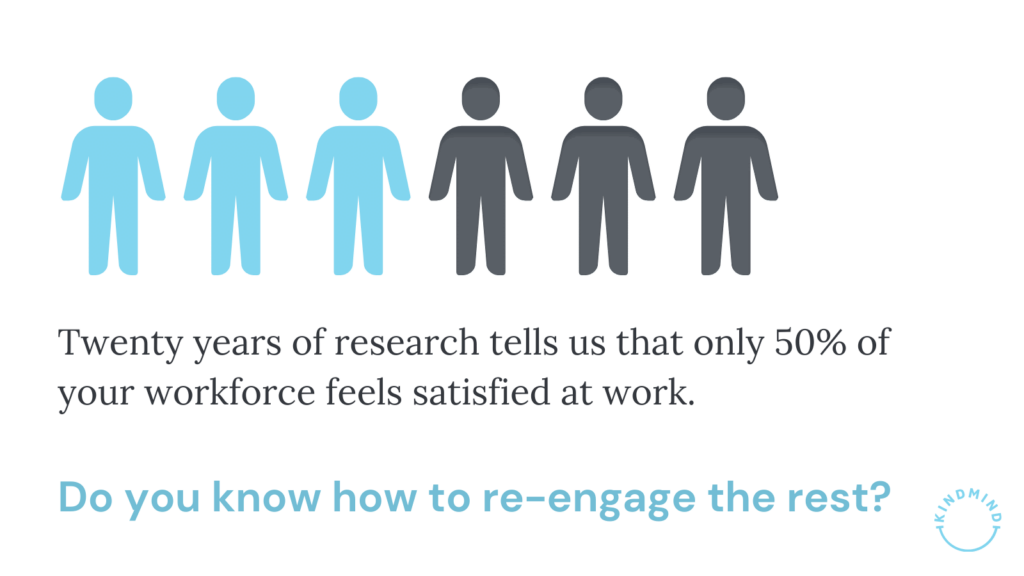You want to know how satisfied your employees are within your business, but you aren’t sure how to measure that. Well, there is a metric called an employee satisfaction score that can help.
Quantifying it can be pretty complex, so let’s dive into our Kind Mind guide and get you started.
What is employee satisfaction?
Employee satisfaction refers to the extent to which employees feel fulfilled and content with their work and work environment. It measures how happy, engaged, and committed employees are to their jobs and organisations.
Employee satisfaction can be influenced by various factors such as compensation, benefits, job security, work-life balance, organisational culture, leadership, job responsibilities, and growth opportunities.
We like to base our inferences on the Single Item Measure of Job Satisfaction, created by Dolbier et al. (2005). The questionnaire has been successfully measured for its reliability and validity, with a study finding that the average level of satisfaction in government employees was a score of 5.31 (out of 7, 7 being extremely satisfied). 90% of the respondents fell within 1.21 of this average.

Why measure employee satisfaction?
Measuring employee satisfaction is vital for several reasons, including:
- Improving employee engagement – Satisfied employees are more likely to be engaged in their work, leading to increased productivity, creativity, and innovation.
- Retaining top talent – Satisfied employees are less likely to leave their jobs, reducing turnover rates and the costs associated with hiring and training new employees.
- Identifying areas for improvement – Measuring satisfaction can help you identify areas you need to improve to create a better work environment and increase staff contentment.
- Boosting morale – When employees feel valued and appreciated, their morale increases, leading to a more positive work environment and job satisfaction.
- Enhancing customer satisfaction – Satisfied employees are more likely to provide better customer service, increasing customer satisfaction and loyalty.
Is there an employee satisfaction calculation formula?
To our knowledge, there is no specific way to objectively measure employee satisfaction. However, there are various methods and tools that you can use to measure the sentiment of your people, so directly looking at satisfaction whilst others will allow for an inference. These include:
Employee satisfaction surveys
A simple likert scale examining the severity of satisfaction can be an effective tool to gather information on.
Employee turnover rates
High employee turnover rates can indicate low job satisfaction, as employees may be leaving due to dissatisfaction with their jobs or the work environment.
Absenteeism rates
High absenteeism rates can also indicate low job satisfaction, as employees may need more motivation to come to work when unhappy with their jobs.
Employee performance metrics
Employee performance metrics, such as productivity, quality of work, and customer satisfaction ratings, can also provide insight into employee satisfaction levels.
Net Promoter Score (NPS)
This KPI measures how likely employees are to recommend their organisation as an excellent workplace. A high NPS score indicates that employees are satisfied with their jobs and feel positive about the organisation.
Employee performance metrics
Employee performance metrics, such as productivity, quality of work, and customer satisfaction ratings, can also provide insight into employee satisfaction levels.
How to measure your employee satisfaction
Here are some steps to follow when measuring employee satisfaction:
- Determine what you want to measure – Identify the specific areas or factors you wish to assess, such as compensation, benefits, work-life balance, job responsibilities, organisational culture, leadership, or opportunities for growth and development.
- Choose a survey method – Determine the best way to conduct your employee satisfaction survey, such as online, paper-based, or in-person interviews.
- Develop a survey questionnaire – Design a questionnaire that includes questions about the areas you want to assess. The questions should be clear, concise, and easy to understand. Consider using a Likert scale, where employees rate their level of agreement or satisfaction with different statements.
- Administer the survey – Distribute the survey to all employees or a representative sample of employees. Ensure that the survey is anonymous to encourage honest responses.
- Analyse the results – Collect and analyse the survey responses. Look for trends and patterns in the data, and identify areas of strength and weakness.
- Take action – Based on the survey results, develop an action plan to address areas of weakness and improve employee satisfaction. Communicate the results and action plan to employees to demonstrate that their feedback is being taken seriously.
- Monitor progress – Regularly monitor employee satisfaction levels to track progress and adjust your action plan as needed.
How often should you measure employee satisfaction?
The frequency at which you measure employee satisfaction depends on various factors, such as the size of your organisation, the nature of your industry, and the goals you want to achieve. However, measuring employee satisfaction at least once a year is generally recommended, as this provides a good baseline for tracking changes over time.
In addition to annual surveys, organisations may also conduct pulse surveys, which are shorter and more frequent surveys that can be performed monthly, quarterly, or semi-annually. Pulse surveys can help organisations quickly identify changes in employee satisfaction levels and take action to address any issues.
It is also important to measure employee satisfaction after significant organisational changes, such as mergers or reorganisations, or after major events, such as a pandemic or economic downturn, as these can considerably impact employee satisfaction levels.
What is a good employee satisfaction benchmark?
There is no specific benchmark for employee satisfaction, but a study by Gallup (Work and workplace study, figure 2) shows us that over the last twenty years, benchmarks for completely satisfied employees were around 50% (Likert score of 4-5), whereas approximately 35-45% (3-4) have been mostly satisfied. However, this score can vary widely depending on the industry, job role, and geographic location.

How to start improving your employee satisfaction
Improving employee satisfaction is a continuous process, and there are several steps that you can take to get started.
- Identify areas for improvement – Conduct surveys, focus groups, or interviews to gather employee feedback on areas where they feel the organisation can improve. Look for trends and patterns in the data to identify areas where employees are most dissatisfied.
- Develop an action plan – Based on the feedback gathered, develop an action plan to address areas of weakness and improve employee satisfaction. Prioritise the areas that will have the most significant impact on employee satisfaction.
- Communicate with employees – Communicate the action plan and involve them in the process. Be transparent about the organisation’s goals and progress, and seek employee feedback on improving the work environment.
- Offer competitive compensation and benefits – Offer competitive compensation and benefits packages to attract and retain top talent. Research to ensure that your compensation and benefits packages align with industry standards.
- Provide opportunities for growth and development – Offer training and development programs to help employees improve their skills and advance their careers within the organisation. Provide clear career paths and opportunities for promotion.
- Improve work-life balance – Implement policies and practices that promote work-life balance, such as flexible scheduling, remote work options, and wellness programs. Encourage employees to take time off to recharge and avoid burnout.
- Foster a positive work culture – Create a culture that values diversity, inclusivity, and employee well-being. Encourage open communication, recognise and reward good work, and train management to implement positive work ethics.
By taking these steps, you can create a positive and productive work environment that promotes employee satisfaction, engagement, and well-being.
It is essential to continually monitor employee satisfaction levels and adjust the action plan as needed to ensure that your organisation is meeting the evolving needs of your employees.
Good luck.
Are you looking for more guides on HR benchmarks? Read our latest articles here.






